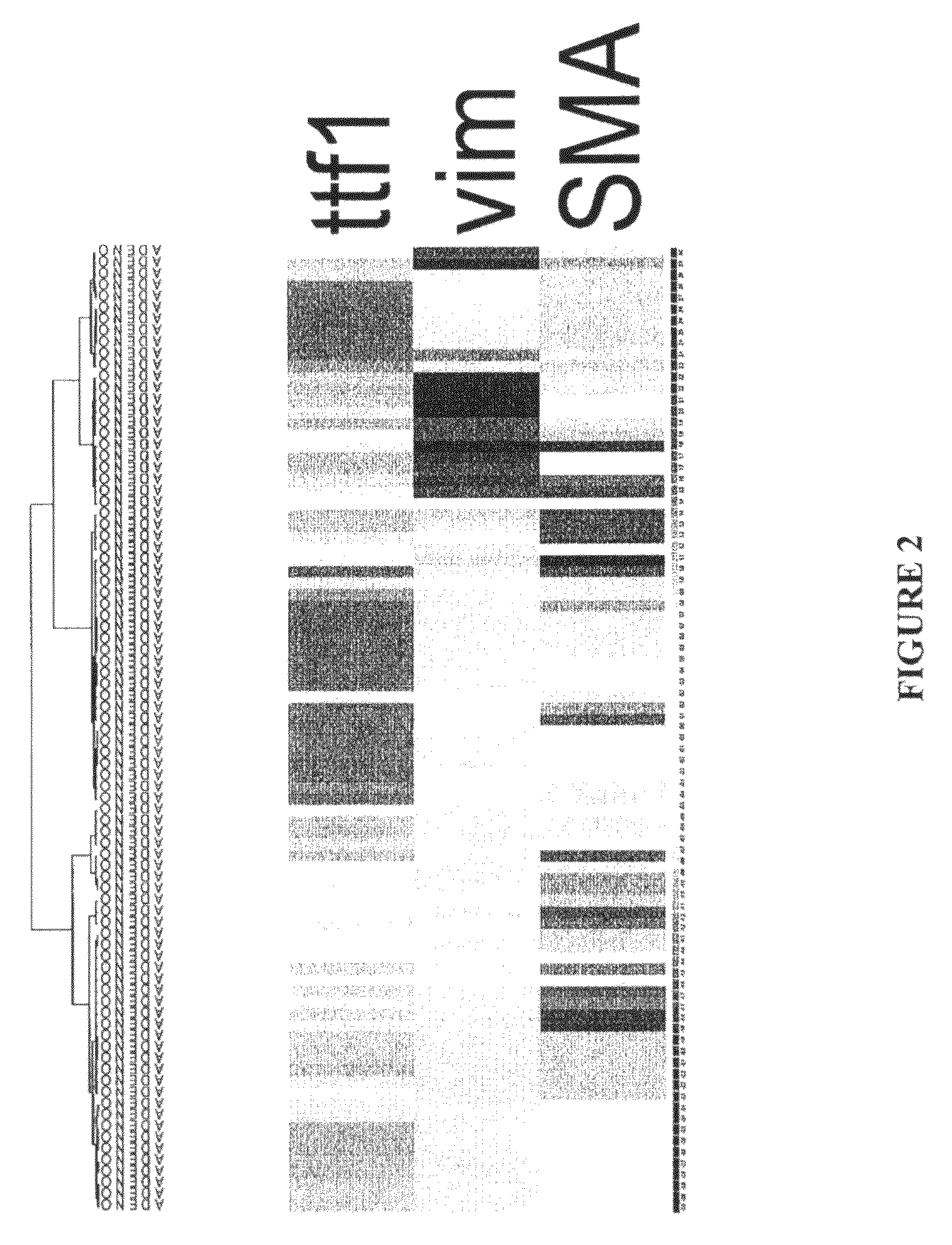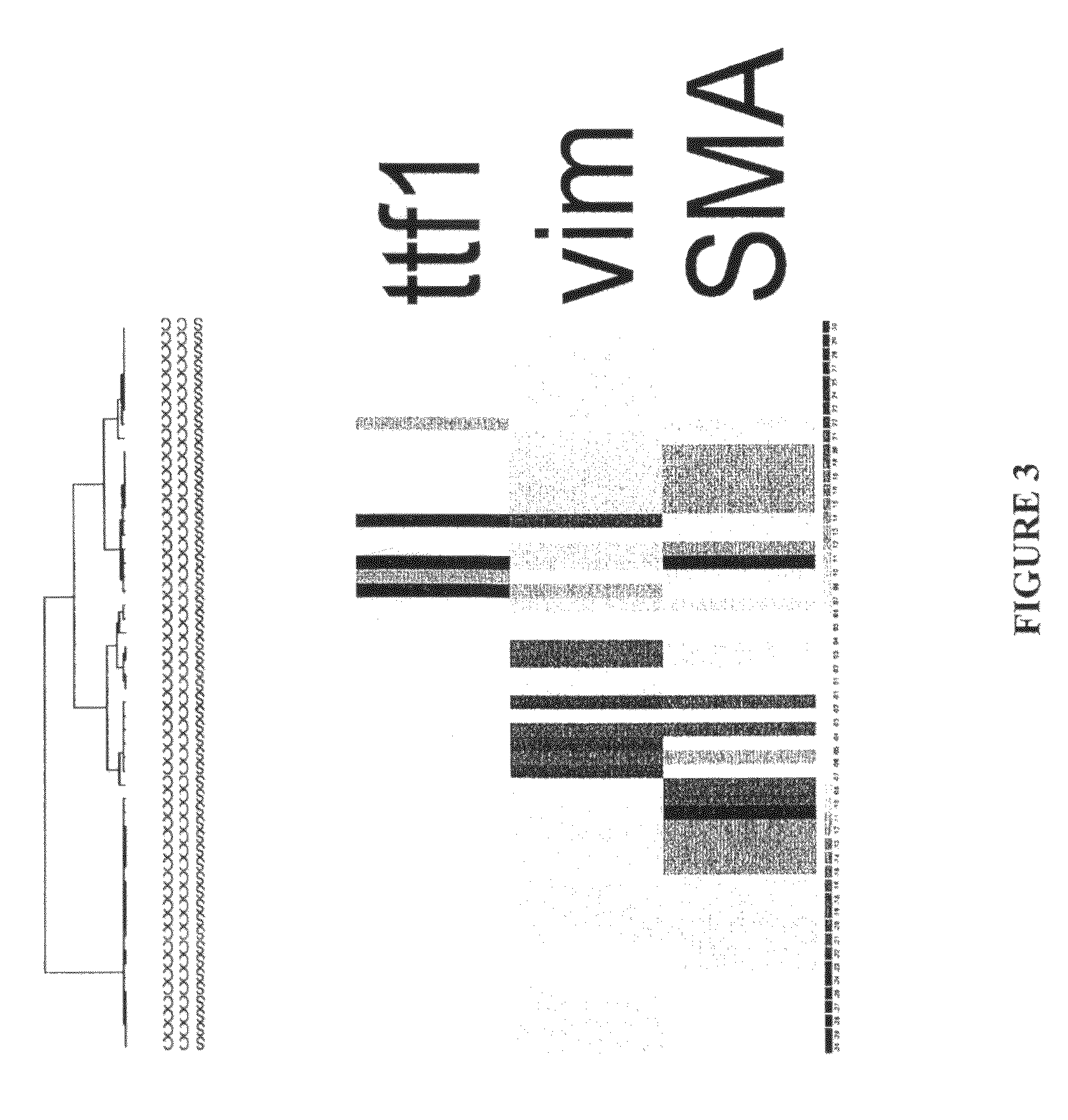Molecular diagnosis and typing of lung cancer variants
a lung cancer and variant technology, applied can solve the problems of false positive, change outcome, and overall disappointing progress in the field of clinical diagnostics and therapeutics
- Summary
- Abstract
- Description
- Claims
- Application Information
AI Technical Summary
Benefits of technology
Problems solved by technology
Method used
Image
Examples
example 1
Immunohistochemical Detection of Gene Expression Subsets of Non-Small Cell Carcinoma
[0106]Background:
[0107]Messenger RNA abundance studies using nucleic acid microarrays allow cluster separation of morphologically similar diseases into molecular subsets. Outcome studies in breast carcinomas and diffuse large cell lymphomas show the relevance of this approach. More recently, lung adenocarcinomas have been subdivided at the mRNA cluster level into magnoid, squamoid, and bronchioid types (1). The purpose of this project was to pick single representative loci from each cluster, and to screen for distinct clustering at the protein level within an unselected set of non-small cell lung carcinoma (NSCLC).
[0108]Design:
[0109]Duplicate-core tissue microarrays were manufactured from 187 surgically resected primary NSCLC. Cases were unselected for morphology, stage, demographics, risk factors, or outcomes. Screening loci were selected using a rational approach based on gene expression profiling....
example 2
Subtypes of Lung Adenocarcinoma Derived from Gene Expression Patterns are Recapitulated Using a Tissue Microarray System and Immunohistochemistry
Background
[0127]Messenger RNA abundance studies using nucleic acid microarrays allow cluster separation of morphologically similar diseases into molecular subsets. Outcome studies in breast carcinomas and diffuse large cell lymphomas show the relevance of this approach. In the field of lung cancer, multiple groups have shown that differences in mRNA abundance distinguish the morphologic variants, including squamous cell carcinoma, small cell carcinoma, and adenocarcinoma. More recently, lung adenocarcinomas have been subdivided at the mRNA cluster level into magnoid, squamoid, and bronchioid types using gene expression array-based technology (Hayes et al. J Clin One 24:5079, 2006). The goal was to translate these findings into more conventional paraffin-based diagnostic tests.
[0128]The purpose of this project was to pick single representati...
example 3
Paraffin-Based Molecular Diagnosis of Lung Cancer Reproduces Morphologic and Molecular Subtypes of Lung Cancer
Background
[0139]Gene expression classifications of lung cancer by microarray have shown potential for guiding therapy (1-2). However, high-quality RNA from fresh tissue for microarray is generally unavailable in clinical practice. A real-time quantitative reverse transcription PCR (qRT-PCR) assay and analytic method for identifying morphological subtypes of lung cancer from clinically obtained formalin-fixed, paraffin-embedded (FFPE) tissues are introduced.
Methods
[0140]Approximately 700 DNA microarrays were analyzed to select genes distinguishing the major histological variants of NSCLC carcinoma and SCLC carcinoma. Previous work has shown that NSCLC is a molecularly diverse group, especially among adenocarcinomas (AC)(3). A 57-gene qRT-PCR assay (52 classifiers and 5 control genes) that molecularly identifies histological subtypes of lung cancer and molecular subtypes of ad...
PUM
| Property | Measurement | Unit |
|---|---|---|
| temperature | aaaaa | aaaaa |
| temperature | aaaaa | aaaaa |
| temperature | aaaaa | aaaaa |
Abstract
Description
Claims
Application Information
 Login to View More
Login to View More - R&D
- Intellectual Property
- Life Sciences
- Materials
- Tech Scout
- Unparalleled Data Quality
- Higher Quality Content
- 60% Fewer Hallucinations
Browse by: Latest US Patents, China's latest patents, Technical Efficacy Thesaurus, Application Domain, Technology Topic, Popular Technical Reports.
© 2025 PatSnap. All rights reserved.Legal|Privacy policy|Modern Slavery Act Transparency Statement|Sitemap|About US| Contact US: help@patsnap.com



